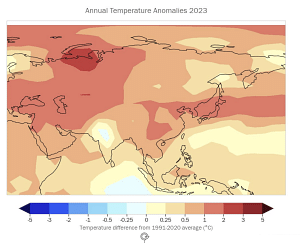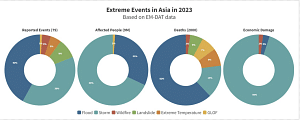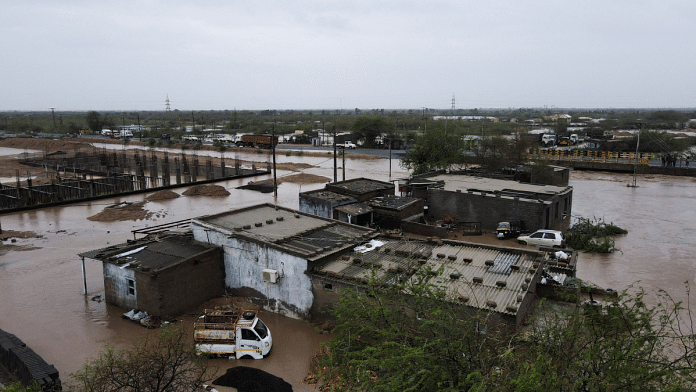New Delhi: Asia was the most disaster-hit region in the world in 2023, pummelled by a record number of weather, climate, and water-related hazards, a new report by the World Meteorological Organization (WMO) has said.
The report titled ‘State of the Climate in Asia 2023’, released by the WMO Tuesday, highlighted that floods and storms caused the highest number of reported casualties and economic loss. WMO is a specialised agency of the United Nations responsible for promoting international cooperation in atmospheric science, climatology, hydrology and geophysics.
The impact of heatwaves was also severe, the study said, adding: “Asia is warming faster than the global average. The warming trend has nearly doubled since the 1961-1990 period.”
WMO Secretary-General Celeste Saulo called the conclusions of the report “sobering”.
He said many countries in the region experienced their hottest year on record in 2023, along with a barrage of extreme conditions, from droughts and heatwaves to floods and storms.
“Climate change exacerbated the frequency and severity of such events, profoundly impacting societies, economies, and, most importantly, human lives and the environment that we live in,” Saulo said.


Also read: Above-normal rainfall, or is it? Why monsoon forecast remains a challenge for IMD
Extreme weather – an upward trend
Countries worldwide have experienced higher-than-normal weather events progressively over the last few years, but the agency said 2023 was particularly alarming when it came to heatwave conditions.
According to the emergency events database, there were 79 disasters associated with hydro-meteorological hazard events in Asia last year, which are associated with atmospheric, hydrological, or oceanographic origin like tropical cyclones.
Of these, over 80 percent were related to flood and storm events, with more than 2,000 fatalities and 9 million people directly affected, the report said.
Armida Salsiah Alisjahbana, executive secretary of the Economic and Social Commission for Asia and the Pacific (ESCAP), which partnered in the making of the report, said vulnerable countries were disproportionately impacted by such extreme events.
However, early warning systems and disaster preparedness plans have saved thousands of lives. For instance, the 2023 tropical cyclone Mocha, the strongest cyclone in the Bay of Bengal in the last decade, hit Bangladesh and Myanmar but damage was controlled by timely warnings.
The report also noted that around 80 percent of WMO member countries in the region released climate services to support disaster risk reduction activities.
Less than 50 percent of the members provided climate projections and tailored products that were needed to inform risk management and to adapt and mitigate climate change and its impact.
Below average rainfall
The WMO report noted that in 2023, rainfall was below normal in large parts of the Turan Lowland (Turkmenistan, Uzbekistan, and Kazakhstan), the Hindu Kush (Afghanistan, Pakistan), the Himalayas, around the Ganges and lower course of the Brahmaputra Rivers (India and Bangladesh), the Arakan Mountains (Myanmar), and the lower course of the Mekong River.
Southwest China suffered a drought, with below-normal precipitation levels nearly every month of 2023, and the rains associated with the Indian summer monsoon were also below average.
It was also reported that over 80 percent of the hydrometeorological hazards in Asia were flood and storm events. Floods were found to be the leading cause of death in reported events by a substantial margin.
In India, Yemen, and Pakistan, floods caused the highest number of fatalities, highlighting the continuing level of vulnerability of Asia to natural hazards.
“Several extreme precipitation events took place in 2023. In June, July, and August, several floods and storm events resulted in more than 600 reported deaths across India, Pakistan, and Nepal,” the report added.
WMO, in their findings, also underscored that many parts of Asia went through extreme heat events last year.
“Japan experienced its hottest summer on record. China experienced 14 high-temperature events in summer, with about 70% of national meteorological stations exceeding 40 degrees Celsius and 16 stations breaking their temperature records,” the WMO said.
In India, severe heat waves in April and June resulted in about 110 reported fatalities from heatstroke. A major and prolonged wave affected much of South-East Asia in April and May, extending as far west as Bangladesh and eastern India, and north to southern China, with record-breaking temperatures, the report said.
(Edited by Tikli Basu)



